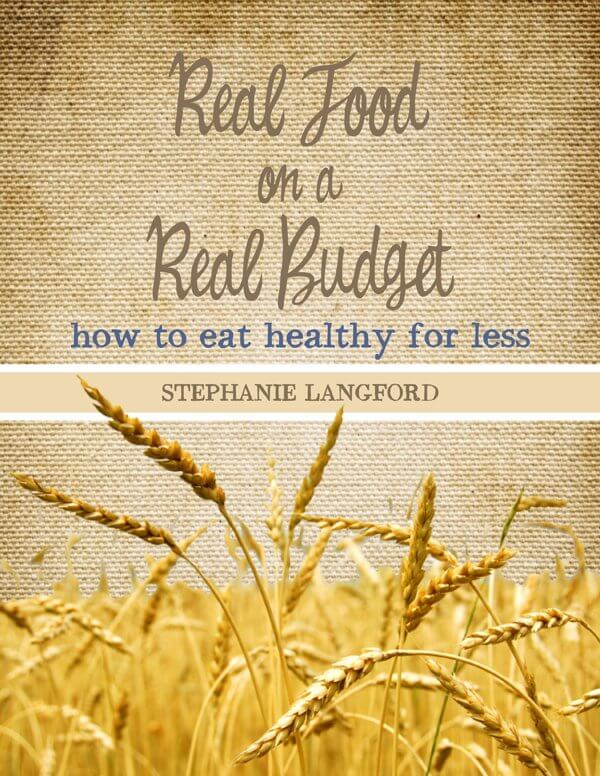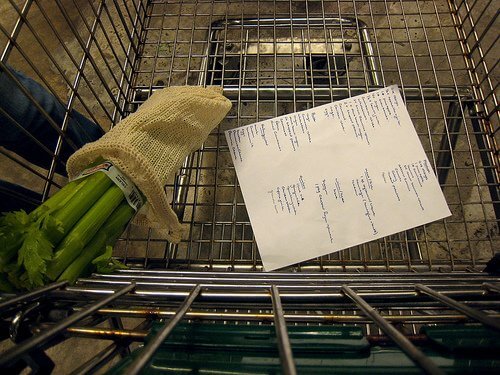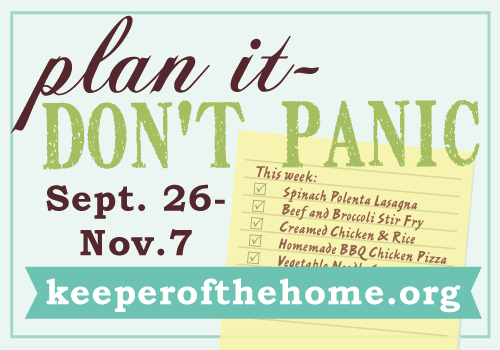Plan It- Don’t Panic Meal Planning Challenge (Plus Grocery Budget Tips)
Welcome to the 2nd week of the Plan It- Don’t Panic Meal Planning Challenge!
I was so excited to see so many of you participating actively in the challenge, whether by sharing a link to your own meal plan or simply posting your meal plan up on the Facebook page. I personally love the accountability of this challenge and how all of you spur me on to keep going. I took a look through quite a few of the meal plans for my own inspiration this week!
Managing the Grocery Budget
This week and next week, I want to address some ways that we can not only use these meal plans to benefit our budgets (ie. save more money!), but also some general grocery budgeting tips that will help you to keep things in check overall.
 I’ve actually written an entire book on this topic, called Real Food on a Real Budget. It goes into far greater detail than I can for the purposes of this post, on the various ways that you can save money while still buying high-quality, nutritious foods.
I’ve actually written an entire book on this topic, called Real Food on a Real Budget. It goes into far greater detail than I can for the purposes of this post, on the various ways that you can save money while still buying high-quality, nutritious foods.
For the duration of the challenge, I am offering it the ebook version for 50% off to all participants using the code “MEALPLAN50”!
What is the Ideal Budget?
There was an interesting discussion on the Facebook page this week about how much various families spend on their groceries each month, how many family members they have, etc. It was intriguing to read through and see how the answers varied.
One concern I had was that we can easily become discouraged when we hear that so-and-so spends only $350 each month to feed their family of 6 and we’re spending $500 for a family of 3, so surely we must be doing something terribly wrong.
While most of us can probably make a lot of improvements to our budget and get the cost down, it’s not as easy as comparing apples to apples. We still need to take into account where we live (city, rural, near farmers?), size of appetites, age of children, how much food is made from scratch, whether we’re using coupons and still buying some conventional items, how much is organic or higher-quality (and usually more costly) ingredients, and all those sorts of questions.
There is no one-size fits all budget.
However.
There are ways that we can all make our budgets better than they currently are, and here are a few ways that I find meal planning in particular helps me to keep my expenses down and food quality up.
How Using a Meal Plan Helps Me Minimize My Spending
1. By truly using up what I already have.
One of the first things I do before I begin meal planning is to take a brief inventory of what we already have for food. Particularly with produce (an area where costs can rack up quickly), this helps me to ensure that nothing goes to waste and that I find a use for even small amounts of random vegetables waiting by their lonesome self in the crisper drawer.
By taking 5 minutes or less to look through the fridge, freezer and pantry with a piece of paper and pen in hand, jotting down anything that you notice will either go bad soon, that you have in abundance, or that could inspire some healthy and frugal meals, I can almost guarantee that the resulting meal plans will save you money every time.

Image by Bruce Turner
2. Only buying what I really need.
As I meal plan, I keep a grocery checklist beside me so that I can make a quick note of anything that I still need to purchase to complete the meals I’m planning for. This list combined with anything I noticed throughout the week that we are out of or low on means that my grocery shopping outings are purposeful and free of wasteful spending.
I do still take note of special sales, discounted items and that type of thing. If I feel that I can do it within my budget, I will buy those things or I may make a quick substitution and use those ingredients for a different meal instead of one that I had originally planned.
That’s more of the exception than the rule, though. Buying what is on my list keeps my trips fast (ever-important when you shop with little ones), my buying focused on what we actually need (not just on what looks good) and at the check-out line, my heart stays where it belongs (rather than jumping up into my throat) when I see the total ring up.
3. Planning for what’s seasonal.
A trip to the apple orchard, then a local farm, then gifts from my parents backyard, means that there are certain things that we have plenty of. Namely, apples, apples, and did I mention we’ve got a few apples?
There are other seasonal goodies we’ll be eating this week as well (end-of-summer melon, lettuce, fall broccoli and cauliflower, potatoes, among other things) but I had to ensure that I could make good use of these apples we are blessedly inundated with at present. So we’ll be eating dutch baby pancakes with apples, apple muffins, coleslaw with shredded apples, sliced apples for snacks, along with making and canning jars upon jars of applesauce.
Seasonal eating is almost always cheaper, no question. When I make a plan, I can plan to use those seasonal foods to our advantage, not to mention our culinary delight.

Image by DeuxXFlorida
4. Making more of my food from scratch.
I recently noticed that when I am taking the time to meal plan well and actually make what’s on my menu, we save money. This is especially true when I am on a special diet with food restrictions. BUT, when I don’t pay attention to my meal plan and end up having to make easy, last-minute substitutions for what I had planned, I have to resort to easy foods rather than what could be cheaper foods.
For example, this week it was easy to suddenly fry up some eggs and pop bread in the toaster when I didn’t get started on muffins the night before or early enough that morning (yes, this is a real example). However, muffins could have used up some of the inexpensive and seasonal ingredients that I already had, whereas this breakfast of eggs and toast means that we will run out of eggs faster than I anticipated, and thus I’ll have to go buy more because we really do need eggs in the house.
5. Planning to use more frugal ingredients.
I find that I don’t necessarily resort to the most cost-effective ingredients when I don’t have a plan. I resort to what’s easiest, because all things being equal (ie. both foods would be delicious) I will generally go towards the path of least resistance (ie. I’ll cook something that comes together quickly, not really taking cost into account). I think this is a fairly general trend that most of us follow when we find ourselves in a pinch!
With careful planning, however, I am apt to make good use of nutrient-dense but cost effective foods like cabbage and root vegetables, beans and legumes, tougher (but cheaper) cuts of beef that need time to simmer.
Next week I’ll share some more general tips for cutting back on your grocery expenses and keeping in line with your budget, whatever that may be!
Our Menu Plan for the Week
Monday
- Breakfast: Soaked oatmeal with raw milk and honey (I’ll do mine with some fruit and cinnamon since I can’t have honey right now)
- Dinner: Beef stir-fry over rice.
- Prep: Thaw roast, do grocery shopping.
Tuesday
- Breakfast: Coconut muffins with apples (based off of this recipe with some adaptations), and frozen fruit smoothie with raw milk.
- Dinner: Roast with gravy, oven roasted seasonal veggies (potatoes, beets, carrots)
Wednesday
- Breakfast: Eggs and toast
- Dinner: Baked potato bar (with various veggies, cheese, sour cream, etc.) and a green salad with chicken
- Prep: Thaw bag of pre-cooked chicken.
Thursday
- Breakfast: Dutch baby pancake, with my addition of chopped apples to be baked inside it
- Dinner: Chicken divan
- Prep: Soak oatmeal. Make sure meat I’m using for Okonomiyaki is thawed.
Friday
- Breakfast: Soaked oatmeal with raw milk and honey
- Dinner: Okonomiyaki (one of our favorite dishes from our time in Japan- it’s sort of a large egg-based pancake, but made savory with some type of meat, sausages or bacon and cabbage inside, topped with mayonnaise)
- Soak beans or lentils overnight.
Saturday
- Breakfast: Coconut flour/banana pancakes (last week we ended up having french toast with fruit instead, but a reader reminded me that there is a coconut/banana pancake recipe in Against the Grain, which I will be trying!), with stevia-sweetened fruit sauce.
- Dinner: Some sort of bean or lentil soup, with coconut flour biscuits.
Sunday
- Breakfast: Egg sandwiches or breakfast wraps
- Dinner: Salmon Cakes (the Fish Cake recipe in Nourishing Traditions that I make using canned wild salmon), sweet potato fries (made the same way as these), coleslaw.
Now it’s your turn to share your meal plan (and I’d love to hear some of your money-saving ideas in the comments as well)!





I was happy to see that in my meal planning I do most of what you have suggested. I spend a LOT of time meal planning, and still we spend over $400 on groceries each month for 3 people. My husband and I have been educating ourselves on where our food comes from, and have felt compelled to start eating organic, and also as local as possible. Problem #1: my husband is a meat eater. LOVES meat. but organic meat can be very expensive. so I have limited the weekly menu to 2 beef nights, 1 chicken night, 1 fish night and 3 vegetarian nights. I adapted this menu from an idea I found for a ‘themed’ menu such as having mexican night, or italian night…etc. I thought this would cut down on expenses, and I have yet to see the savings because of Problem#2: my husband and step-son HATE repetition. So I try to come up with a variety of meals each month… and as seasons change, well you can imagine I spend a LOT of time meal planning. (UGH!) Can you see? is there something I am missing that might make this any easier?
@rebecca, I do struggle with those same challenges. My family also doesn’t like repition, and it seems that we are often making either seasonal or dietary changes for various reasons. One thing that has helped me is to just have a very wide range of recipes available to me, and to try to record our favorite recipes for different seasons/diets. I do my best to keep previous meal plans, and this can be really helpful. I’ll hardly ever go back to a really recent one, but I will frequently go back to ones from 6 months ago, even a year or two ago, and get inspiration from them, that helps to cut down on the intensive planning time.
As far as cutting expenses further, your themed planning sounds great but are you utilizing cheaper versions of those foods? Like stew beef or ground instead of more expensive cuts of beef, buying whole chickens instead of breasts, etc.? That can help to make a big difference.
But also, I don’t think that $400 is necessarily unrealistic for 3 people, depending where you live and the kind of costs that you have. You definitely might be able to cut it down further, but not knowing where you live and exactly what you buy, it’s hard to say whether that’s too high or not.
Lastly, I would look at things like snack of convenience foods, drinking lots of beverages (we hardly ever buy juice, and even though we drink raw milk, we don’t consume it with most meals). Are you making breakfasts and snacks from scratch, or purchasing health food items like cereal or granola bars? That can also make a huge difference.
Just a few thoughts! Obviously it’s hard for me to really evaluate. Perhaps other ladies have some suggestions?
@rebecca,
For easy variety, try building up a repetoire of sauces. You can marinate chicken 10 different ways and have a different meal with very little effort. Then just add a vegetable, maybe a starch and you’re good to go. I keep a few homemade spice mixtures on hand and I can easily throw together Mexican chicken, Asian chicken, barbecue chicken, etc. Use the same seasonings with ground turkey or ground beef and you have all new meals!
I just found out last night that you can go to allrecipes . com and by the search bar you can click on “Ingredients”, type in whatever you have laying around the house and it will come up with a recipe(s) that uses those ingredients. 🙂
@Lorie, Yes, I love that feature!
Thanks for hosting this challenge…I would love to get the recipe for that Japanese dish if you ever want to share it! 🙂
@Krissa, One of these days I will. It is definitely worth sharing. 🙂
You know I started doing meal planning earlier this year out of necessity – I wanted to only shop every 2 weeks so I decided to pre-plan it. I was absolutely astonished by how much easier it was to stick within my budget. Not only that, but there’s no more “What’s for dinner?” nights. I do move stuff around like if I forgot to do prep ahead of time but I try to plan for a fair amount of meals that come together quickly. I found that if I planned all meals that were more work it was kind of a failure. But yeah, out of anything I do to save money, planning my meals and shopping every 2 weeks was the big one. I almost wouldn’t mind just going once a month but my produce wouldn’t last as long that way. Takes a bit of adjustment to buy 2 weeks worth of food mentally, but it was worthwhile.
Bethany, once you get a plan for shopping only every two weeks, it is easy to plan for major shopping once a month. You notice, I said “major”.
What I do is shop for the majority of my needs once a month, then, in between, I just do a “perishables” run. I buy milk, fruit, salad makings, veggies, etc for the next 2 week period. I can also pick up items that were forgotten on the last trip or we ran out of unexpectedly and I can also take advantage of sales of items we regularly use. It really is a win-win situation because my shopping trips stay defined, I have a month of frugal meals planned (so my menu planning time is used wisely), I can usually visit a store more local or a farmer’s market without trying to fit in 2 or 3 stops on major shopping day, and my family has learned that we have to wait for shopping day for certain things.
I suggest you try it, you might find the same benefits.
I love doing this – such a huge time saver, not to mention money saver.
Between your challenge & the October #Unprocessed Food Challenge at Eating Rules, I feel like I’m getting a handle on those areas of the diet I hadn’t dealt with yet. Thanks for the continued inspiration!
@Barb @ A Life in Balance, Oh, you’re doing both challenges at once. That’s fantastic. You’re so very welcome!
I missed last week. Not sure what happened, but here I am this week! Got my menu plan done and up on my blog! Thanks for the kick in the butt to get this done!
In just one week I’ve had a series of epiphanies. Reading last weeks challenge made me realize I should buck up and try and control the chaos.
This post reassured me that I’m doing better. The single most useful tip is to take inventory of what you already have. I thought of that yesterday and planned around it. Instead of spending $200 at the store last week I spent $94 and still have plenty of food lingering. I have leftovers, and plenty of stuff that was already here that I planned to use instead of buying more stuff.
My husband and my kids are picky eaters. My husband does not like repetition, leftovers or anything moderately healthy. I seriously struggle with making healthy meals that he will eat. My kids are easier to please and they even have allergies!
My hubby is also very much against repetition. I actually started my own meal planning project last week to address that issue and posted it on my blog on Monday. Just after that I discovered the Keeper of the Home menu planning challenge! Perfect timing! Since I’m fairly new to “real” foods, most of my go-to recipes got tossed or need to be made-over. I’ve got a lot of work ahead of me, so I’m making sure not to waste all of this effort. It would take awhile to explain it all, but you can read my game-plan on this post:
http://creativechristianmama.com/how-to-live-creatively%e2%80%a6-when-it%e2%80%99s-not-your-passion/
I’m hoping that once I’ve done each season, it will cut way down on the work I have to do each week to have a wide variety of healthy and yummy meals! 🙂
I am so glad you mentioned Okonomiyaki!
We loved it when we vacationed in Japan.
Would you please provide the recipe of how you cook it – I’d love to surprise my family with it!
@Sarah, I might just have to share the recipe soon. 🙂
Just found your blog, and I’m loving it so far 🙂 Right now I’m trying to find that magical balance between healthy eating, and staying within the parameters of my current $300 a month grocery budget, for my family of 5.
for you would-be-planners with repetition-adverse families, let me give you a suggestion.
Pick themes that are easy to modify.
If you are planning by meats [2 beef, 1 chicken, 1 fish & 3 no-meat meals], along with switching around the recipes you prepare with those meats, switch around the days you serve them [this week, beef on Tue & Fri, next week, Sun & Wed).
If your theme is method or style, don’t always do spaghetti on Italian night. Make baked zitti or spaghetti pie, chicken alfredo or linguine carbonara, pizza or calzone. If it is Asian night, have stir fry over rice one week, over noodles the next, sushi or egg rolls another and so on. And again, if repetition is the problem, don’t always have Italian night on Tuesday!
I use a combination of themes for my planning. First, I plan the starch: potato, rice, pasta or bread. I try not to have 2 potato nights or rice nights or whatever in a row. Then, I plan the proteins so they aren’t the same in a row. After that, it is easy to think of an actual recipe that would fit that criteria. I’m not rigid about this no-repeats-in-a-row thing but it is a good guideline. One of the ways it might repeat a little is to have roast chicken, mashed potatoes, gravy and green beans on Wednesday and then Thursday have the left over chicken as a stir fry over rice. Even though chicken was 2 nights in a row, it was prepared so differently that no one even noticed.
I hope these tips help a few of you find the freedom and peace that menu planning can bring. There are so many other things, as homemakers, that require our energies it is good to be able to “spend” the energy more wisely.
Great post and good ideas. Thanks! I just posted my menu for the week, crazy Monday so I did not get around to it till today.
I’ve posted my meal plan, a day late… but I am on vacation. 🙂
I bought the ebook “Real Food” yesterday, but was unable to open the link to download. I sent an email yesterday asking for it to be resent. I appreciate you offering it for 50% off as I’ve had my eye on it for awhile. I can afford that price, thank you!
I am anxious to get it and start reading =)
Thanks,
Lori
I really love these series that you always seem to come up with. I loved the meal planning one with the freezer cooking one awhile back. This one is coming right at a time when I am really trying to cook better to deal with my sons add and sensory processing issues.
Thank you so much for the informative posts!
@Lilly A, Oh good, I’m so glad these series have been helpful for you!